Brief

China, viewed as both an opportunity and a threat, has long been a top agenda item in executive meetings across industries and around the globe. It is no wonder then, with China’s economic plan calling for the investment of more than $100 billion toward attaining leadership positions in the semiconductor space, that industry executives from the world’s most successful and most innovative firms are actively considering how to both capitalize on and defend against China’s growing ambitions.
Given the size of China’s tech-savvy domestic market and its role as the world’s leading manufacturer of electronics exported to other markets, it should come as no surprise that a disproportionate quantity of silicon is destined to flow to (or through) China. We estimate that by 2020, this will amount to nearly 55% of the world’s memory, logic and analog chips. China, however, produces only about 15% of these semiconductors, up from about 10% a few years ago but still a long way from closing the widening gap between supply and demand. China aspires to play a more significant role in the global semiconductor industry, producing more of the microprocessors and memory chips that go into locally produced smartphones, tablets, sensors and other consumer devices and industrial equipment, whether for domestic consumer demand or eventual export.
With this goal as a guide, China has developed several semiconductor clusters across the country (see Figure 1), and over the next 10 years the national and provincial governments plan to invest as much as an additional 720 billion renminbi ($108 billion). Beyond the consumer and industrial demand, some of this investment aims to support China’s strategic interests in developing semiconductors for sensitive industries such as defense or telecommunications, reducing its dependence on international chipmakers.
The high barriers to greenfield entry suggest that, in most, cases China is likely to partner with existing firms. It is pursuing deals with market leaders and laggards, taking into consideration their goals, technology needs and the reality of restrictions by foreign governments. Multiple Chinese companies have signaled their interest in investing in multinational semiconductor firms, with some recent overtures more successful than others. In January 2016, the government of Guizhou Province took a 55% stake in a joint venture with Qualcomm to produce advanced server chipsets, and Tsinghua Unigroup invested $600 million to become the largest investor in Taiwanese chip assembler Powertech. In contrast, China’s proposed deals with Western Digital and Micron Technology both fell through for a variety of reasons, including China’s cooling economic growth and the threat of scrutiny by US regulators. Despite these obstacles, we expect to see more M&A attempts in this space in the not too distant future.
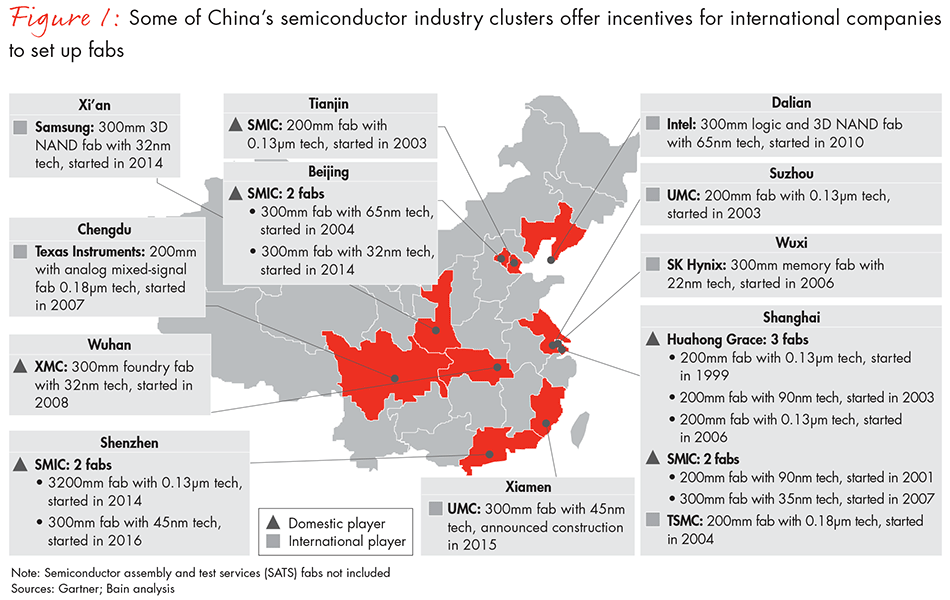
For international players in the semiconductor industry, China’s ambitions may appear daunting. Certainly China’s vast market, deep pockets and long patience in pursuing economic goals suggest that multinational companies will require a clear strategy for working with China in this space. That is not to say that global semiconductor players lack leverage and negotiating power in their dealings with China. China has a mixed record of entering new markets, and its state-owned enterprises and government organizations adopt different strategies depending on market conditions and the relative strengths of competitors. Given the high entry barriers, China will likely continue to work closely with international companies as it nurtures its own industry. Executives who understand China’s goals and who adopt a mix of offensive and defensive strategies stand to benefit as this market develops.
China’s record in market entry
China’s strategy for entering markets varies depending on several competitive dynamics relating to the degree of control by Chinese companies vs. international competitors in areas such as technological leadership, access to intellectual property (IP) and overall market control (see Figure 2). To improve its competitive position, China generally seeks to control demand as much as possible and gain valuable IP. Of course, the placement of any industry sector on this framework is not constant and can change over time—in fact, one could say that the goal for China in most cases is to accelerate a shift to the lower right box of Figure 2 whenever and wherever possible.
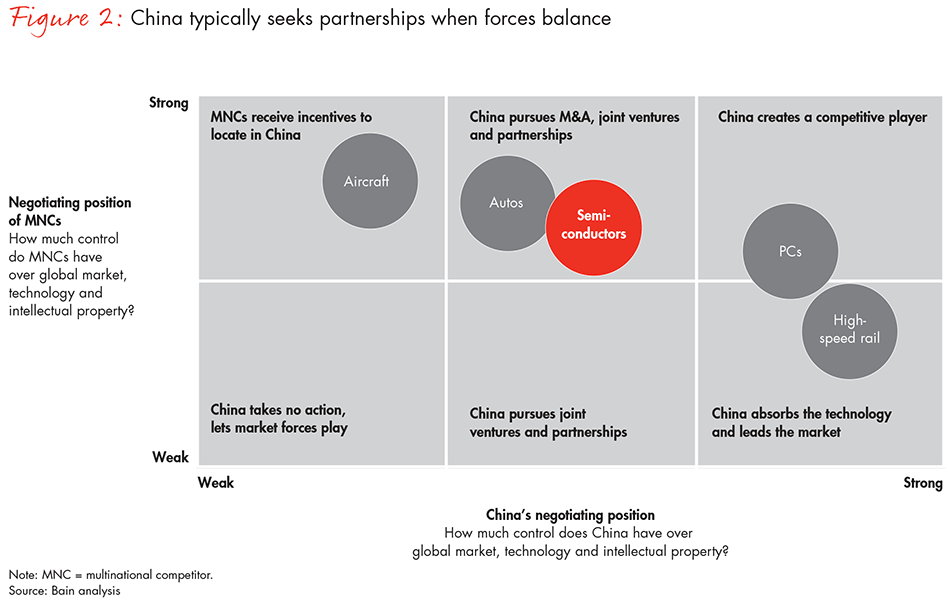
In high-speed rail, China’s enormous bargaining position enabled it to rise quickly to a market-leading position. While demand for high-speed rail stagnated across much of the world, China built the world’s largest high-speed rail network, with the government controlling demand. Manufacturers had little flexibility other than to accept China’s strict IP transfer and limited ownership conditions if they wanted to participate. Within 10 years, China dominated the high-speed rail market, not just domestically but globally.
In contrast, China’s government could not directly control consumer demand in the automotive industry. Multinational players with strong brand and technology advantages had little interest in sharing their most advanced IP with China. In this case, China sought to encourage foreign leaders such as Volkswagen and General Motors to invest in domestic production and form local joint ventures. Now, decades after VW and GM entered China, they still retain leadership positions in the market.
In aircraft, China’s progress has been much slower, due to poorly funded efforts and less technology transfer from market leaders Boeing and Airbus. COMAC (the Commercial Aircraft Corporation of China), the state-owned aerospace manufacturer, is years behind on delivering planes that are likely to be outdated when they are launched. Boeing and Airbus are establishing facilities in China, but they are focused on less IP-intensive steps of the value chain such as assembly or finishing. Airbus has operated a final assembly line in Tianjin since 2008 as a joint venture with a Chinese consortium of China Aviation and the Tianjin Free Trade Zone. Boeing announced in September 2015 that it would also build a plant in China to install interiors and paint exteriors on 737 airliners destined for China’s market.
In semiconductors as in automotive, the Chinese government has only limited control over demand. Consumers and businesses around the world will continue to choose systems and devices based on quality, technology, value and brand, which means that to remain competitive, the producers of those systems and devices, whether Chinese or international, will have to choose chips that can deliver the right performance at the price required by end users. To gain a material share in the global market, Chinese semiconductor manufacturers would need to catch up with foreign players in terms of technology and production costs. China could directly control the demand of enterprise products for Chinese institutions and state-owned enterprises—a critical segment but one that represents only a fraction of the semiconductors produced in China. Moreover, China’s membership in the World Trade Organization will limit its ability to place foreign ownership restrictions or IP transfer requirements on manufacturers as it did with high-speed rail.
Challenges for China entering the global semiconductor market
The first question for China as it chases chip leadership is where to enter the market. Memory, logic or analog chips? Fabless, foundry or integrated business model? Each of these require foundational IP and ongoing innovation, as well as the engineering talent to sustain it. These factors are self-reinforcing, which is great for market leaders but makes entry difficult even for the most well-funded challengers. For example, in leading-edge process technology, only a handful of players in each segment are able to sustain their R&D investments in a “winner(s) take all” industry dynamic (see Figure 3). These players have few incentives for sharing this core IP with potential competitors from China or anywhere else.
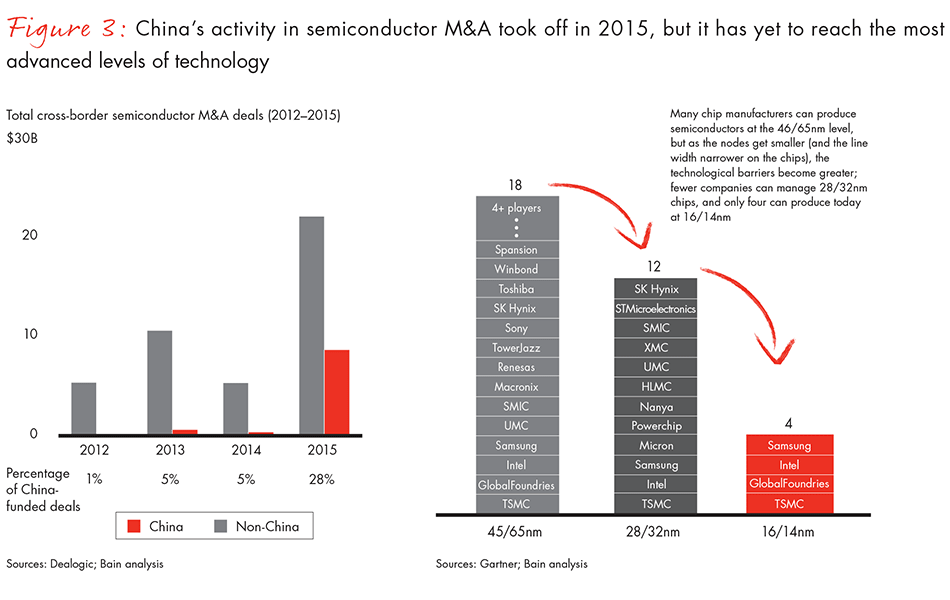
Foundry. As noted, China’s biggest challenge, especially in logic, may be with leading-edge manufacturing—as currently, even China’s domestic fabless design leaders need to go outside China to have their most advanced leading-edge chips manufactured. On this front, the experience of sovereign wealth funds from Southeast Asia to the Middle East and beyond may serve as an informative tale. Billions of dollars have been invested over the past three decades to develop credible challengers to market leaders such as TSMC and Samsung. While the jury is out on the final outcome of these investments, they create the potential for China to have one more global competitor with which to contend or to be entering a space where patient capital and commitment will have proven insufficient.
The foundry model is more interesting, in many respects, if one considers foundries that rely on older process nodes. China is already building a strong ecosystem around low-cost devices, including smartphones and tablets, and domestic players are continuously strengthening their capabilities, with an ongoing move from assembly to system-level design and into silicon-level design. Much of this ecosystem doesn’t necessarily require leading-edge manufacturing capabilities, and China’s SMIC may become the foundry of choice for technology that is one or two generations behind the leading edge but good enough for many uses.
Fabless logic. Logic is a critical industry for China, given the strategic and security benefits it stands to gain beyond pure economic outcomes. A strong presence in logic would improve China’s ability to serve sensitive domestic industries such as defense, telecommunications and finance without having to rely on the US and other international suppliers.
China has made meaningful progress in mobile through Spreadtrum and HiSilicon, each fabless design houses, the latter of which is a Huawei subsidiary. Meanwhile, Qualcomm and Intel are looking for ways to sustain growth in logic, which has seen slowing growth and escalating R&D costs (see Figure 4). Both have already shown a willingness to work with the Chinese market, which will help China nurture its own capabilities.
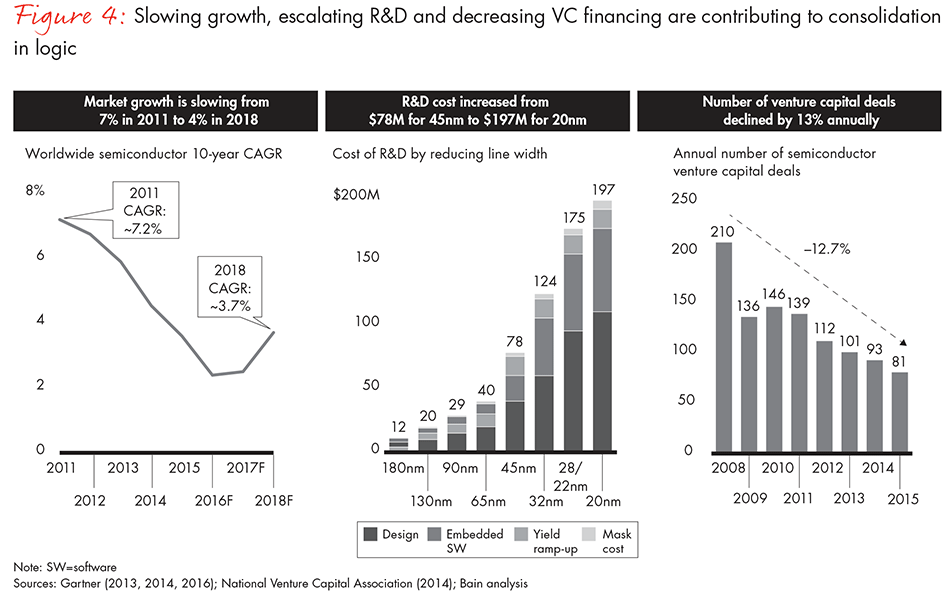
Logic is also a key platform for a new generation of uses in data centers and the Internet of Things. New architectures, including FPGA, GPGPU, and RISC processors such as ARM and RISC-V, each offer their own unique competitive advantages and could threaten the dominance of market leaders.1 While it would be difficult, China might also consider pushing its own platform, similar to the establishment of TD-SCDMA in the mobile industry.
Memory. Considering that leadership in memory has migrated over the past several decades from the US to Japan to Korea, China could see this market as more attractive in terms of gaining a strong position. While no Chinese company currently has leading-edge technology in memory, there have been signs of strong Chinese interest in the space. For example, XMC, which has a partnership with US flash memory producer Cypress Semiconductor, has announced a multiyear, $24 billion investment to ramp up production of memory chips. XMC, which merged with Tsinghua Unigroup in July 2016, has begun building a fab to make NAND flash chips and plans a second plant that will develop DRAM. This is a significant investment but still short of the $35 billion to $50 billion that our analysis suggests it would take to launch a greenfield effort over 8 to 10 years—and even this would carry a high risk of failure, given the gap with current global leaders who dominate the market. Recall that Taiwan tried and failed to enter the market in the late 1990s and early 2000s, when the industry was less consolidated and barriers to entry lower than now—and Taiwanese firms burned a combined $40 billion in the process.
China may take a more rational approach, waiting out the current cycle. Although the DRAM market is fully consolidated, NAND market structure is different (see Figures 5 and 6). The current NAND market, with five major players vying for share, may prove unsustainable, and the introduction of 3D NAND may trigger industry restructuring and consolidation as some players fail to navigate the technology transition. Also, in the longer term, introduction of next-generation memory such as 3D XPoint will change the industry dynamics, creating opportunities for China to acquire or form partnerships with existing players who may need a well-funded partner.
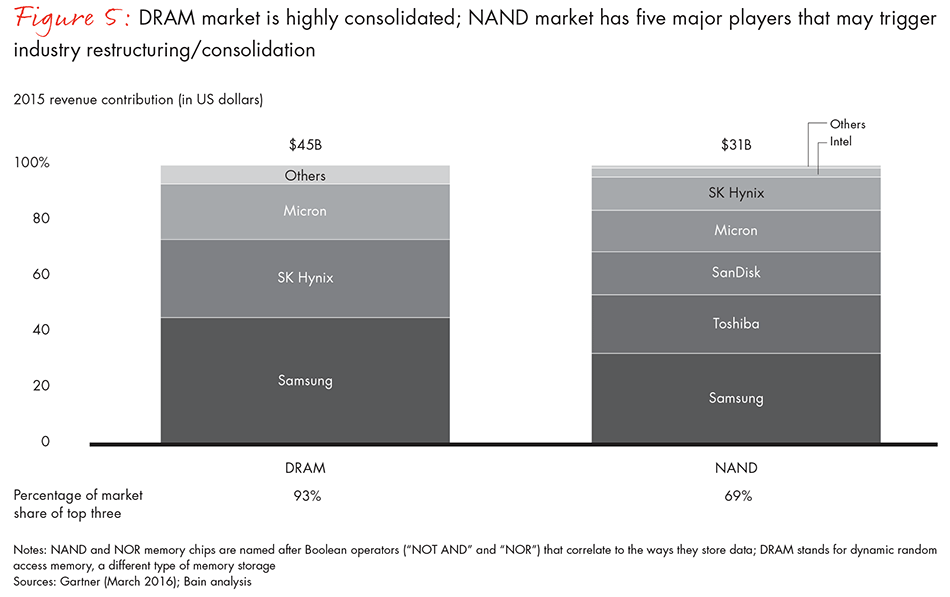
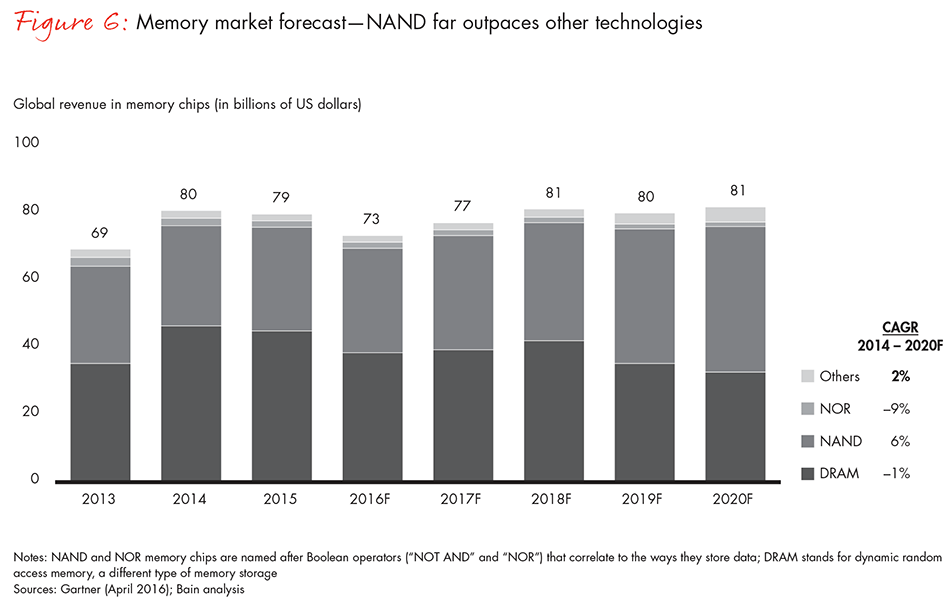
Analog. Analog represents another opportunity for China as the rise of applications related to the Internet of Things (IoT) creates an explosive demand for analog semiconductors for sensors, power management and signal processors. China’s aggressive approach to electric vehicles and new energy creates a strong incentive for analog players to enter China, and given the fragmented nature of the industry, China would have opportunities to consolidate selectively. There could also be an opportunity for SMIC or another player in China to invest in developing a 200mm fab focused on analog, consistent with the theme of providing manufacturing capacity for IoT technologies.
A proactive approach
China’s commitment to play a larger role in the global semiconductor market is real and significant, and international semiconductor companies cannot afford to sit by and play a reactive game. In addition to understanding China’s position and options, industry executives in international firms should also consider a range of offensive and defensive moves.
- First, take a scenario-based approach to anticipate and react to China’s potential moves based on its ambitions and the evolving competitive environment.
- Seek opportunities to invest in China and expand your footprint, primarily through partnerships based on older-generation technologies or in subsegments in which your position lags and partnering with a challenger in China would improve your prospects against market leaders.
- Keep in mind the lessons learned from other industries in which international players have developed healthy partnerships with Chinese companies.
- Finally, understand that markets and industries in China are not monolithic. There are very real competitive forces in play, and given the time required to build a semiconductor capability, choosing the right partner may be more important than gaining first-mover advantage in any particular segment.
Chinese semiconductor companies have a different set of opportunities at play, and so their options are more focused on exploring partnerships and finding a place in the market that positions them for success.
- Since reaching scale through organic growth would be an almost insurmountable challenge, domestic Chinese players should look for partnerships (often with followers with strong IP that could benefit from funding and access to China’s market) and takeover opportunities of companies looking to leave the industry or divest, both inside and outside of China.
- For partnerships, focusing on win-win collaborations with international partners to jointly develop, adapt and produce technologies that can be channeled to the Chinese ecosystem could be more effective than a pure low-cost or IP transfer play.
- They should also seek out targeted M&A opportunities that allow them to build up capabilities and talent. Proactively managing regulatory and IP issues, and implementing effective post-merger integration plans, will help ensure successful deals and talent retention. Any failed takeovers will make future deals harder in an already small market.
- From a strategy perspective, a well-focused play is more likely to succeed than a broad or general-purpose approach. Successful companies will focus their strategies to address specific segments of the supply-demand gap in China, leading with market needs while broadly aligning with government priorities and incentives. Becoming a specialist within a defined ecosystem can create sustained value as the China market continues its evolution and rapid growth.
1Field programmable gate arrays (FPGAs) are highly modular, programmable architectures that are more flexible and adaptable than traditional architectures but that also perform at lower levels, require more silicon area and consume more power. General-purpose graphics processing units (GPGPUs) go beyond traditional graphics processing units by allowing applications to handle computation that is typically handled by CPUs. ARM and RISC-V are CPUs with reduced instruction set computing (RISC) architectures that typically consume less power than equivalent CISC architectures like Intel’s.
Kevin Meehan and Florian Hoppe are partners with Bain & Company in Singapore. Jihyo Lee is a partner with Bain in Seoul, and Steven Lu is a partner in Bain’s Shanghai office. All four work with Bain’s Technology practice, which Kevin leads in the Asia-Pacific region.
The authors would like to acknowledge the contributions of Alessandro Cannarsi, a principal with Bain & Company in Singapore.





